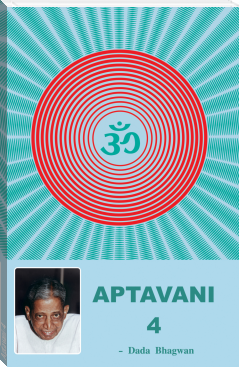Beyond No Self by Daniel Erway (top rated ebook readers .TXT) 📕

- Author: Daniel Erway
- Performer: -
Book online «Beyond No Self by Daniel Erway (top rated ebook readers .TXT) 📕». Author Daniel Erway
BEYOND NO SELF
by Nirmala
Copyright ©2008 by Daniel Erway (Nirmala)
Endless Satsang Press
Nirmalanow@aol.com
www.endless-satsang.com
*
BEYOND NO SELF
The spiritual journey is a movement away from over-identification
with the body and mind to the rediscovery of our true identity as infinite
Being, and this can be two different movements. The first is dis-identification with the body and mind. Since identification is simply a
movement of thought, dis-identification is simply a movement away from
thought. The ego identification that we experience most of the time is the
result of repeated thoughts about “I”, “me,” and “mine.” That is all there is
to it, but while we are thinking these thoughts the sense of self is contained
in them. And since most of our self-referencing thoughts are about our body,
our thoughts, our feelings, and our desires, the sense of self is usually
contained in the body and mind.
Dis-identification from the thought form of the ego can occur
whenever there is a deep questioning of the assumption in most of our
thoughts that we are this body and this mind. Inquiry using the question,
Who am I? can naturally weaken the assumption that I am the body and the
mind. In fact, any deep questioning of our thoughts and assumptions can
loosen our over-identification with thought, since so many of them are not
very true. Experiences of no thought can also weaken the identification
because in the absence of thought, there is an absence of identification. We
all experience this when we get so caught up in what we are doing that we
completely “forget ourselves.”
Alternatively, directly sensing the presence that is aware of the
thoughts can also dis-entangle the tendency to identify with the thoughts.
The second movement of the spiritual journey is this recognition, or
realization, of your true nature as presence or limitless empty awareness. It
is a wonderful surprise to discover that everything that really matters in life,
including peace, joy, and love, is found in this empty awareness. This
emptiness is incredibly full and rich. It has intelligence and strength and
compassion. Whenever we experience a deeper quality of Being such as
clarity, peace, insight, value, happiness or love, it is coming from this
spacious presence.
The surprising thing is that while these two movements can occur
simultaneously, they can also happen apart from each other. When this
happens, the movement from ego identification to our essential nature is not
complete. For example, you can question deeply your own thoughts until the
false assumptions in them are seen through. The over-identification that
results from constantly thinking about me and mine and my body and my
problems can’t survive closer examination. It can be a shock to see how
completely we assume that I am this body and I am this mind, and an even
bigger shock and relief to discover that it is just a thought, and it is not true.
The identification is really just a thought. There is no actual equivalence
between you and your body or your mind. You are that which experiences
the body and the mind, but you are not contained in them.
Even though this is a profound insight and a huge relief (after all if I
am not my body, then these are not my aches and pains; and if I am not my
mind, then these are not my problems), by itself this insight only reveals the
false assumptions. It does not reveal the underlying truth. And since the
underlying truth of your nature is more of a heart-centered experience, it is
possible to dissolve the ego without touching your true nature. In a sense,
you can wake up in your mind, but not in your heart.
When this happens, there is both the sense of relief from all of the
grief caused by the over-identification with the body and mind, and often a
deep sense of meaninglessness. If “I” don’t exist, then what is the point? It
doesn’t matter anymore what the fictional “I” does or what happens to it. In
fact, nothing matters at all because it is so clearly all an illusion.
When seekers are led or just find their own way to a deep experience
of no-self, they can then form a new more subtle belief that this absence of
self is all there is. “I am not my body, I am not my mind, I do not exist” are
seen as the final conclusions. From a purely logical perspective, what more
is there to say, since there is no one here to say it or hear it! And while these
conclusions are true, they are not the whole truth.
Underlying all of the activity of the mind is the non-conceptual reality
of Being, or our true nature. Underlying the concept of apple, one can
experience the reality of a sweet, red piece of fruit. However it is more
subtle when it comes to our true nature, because the reality underlying our
false identification with the ego is not physical. It is a pure empty aware
space that is full of the subtle substance of presence in all of its essential
forms: peace, joy, love, clarity, strength, value, and much more.
How can that beempty space that is full of everything that matters?
The mind cannot grasp it fully, as presence exists beyond concepts and even
beyond its own forms; and yet, that is what you are. You can experience it
with more subtle senses than the physical senses and the mind. Ultimately,
you “sense” it by being it. You just are this full empty presence.
It is this second movement of realization of essence, presence, and
fullness of Being that counteracts the belief that since I (as ego) do not exist,
therefore nothing exists and all is illusion. It gives a heartfelt sense of
meaning and purpose back to this relative life of the body and mind, not as a
means of gratification to your idea of yourself, but as a pure expression of
the wonder and beauty of this deeper reality. Instead of living a life in
service to the ego’s wants and needs, you can find yourself fulfilling the
deepest purposes of a human life: to serve and express freedom, joy, beauty,
peace and love. By itself the realization of no-self can end up dry and
lifeless, but when the heart opens wide to the bigger truth of the true Self,
life is anything but dry and lifeless.
It is also worth mentioning that the opposite can occur: At any time,
your awareness can move directly into pure presence and be filled with a
sense of the essential limitless goodness of your true nature. And while any
experience of true nature does to some extent loosen the identification with
the limited idea of yourself we call the ego, since it doesn’t compute to think
of yourself as a limited body and mind when you are experiencing the bigger
underlying reality, an experience of true nature by itself doesn’t always
dissolve the ego completely. Having a direct experience of deeper truth
doesn’t take away your inherent capacity to identify. It doesn’t render you
incapable of thought, so you can still return to thinking of yourself as a
limited self, even if it is now a limited self that has tasted your true nature.
So if the habit of identification with the body and mind does continue,
it can still be necessary to deconstruct the mistaken beliefs related to ego
identification. There is a place for questioning and inquiring into the false
beliefs and assumptions of our identification with the body and mind, and a
place for questioning and inquiring into the underlying reality. The
difference is that the inquiry into true nature is not a purely mental activity.
Because of the subtle nature of presence, the inquiry itself has to be subtle
and whole hearted. To discover what is really here in the truest sense
requires subtlety, patience, persistence, courage, tenderness, compassion,
curiosity, and ultimately everything you’ve got! The momentum of our usual
identification with physical reality and with our purely mental thought forms
shapes our perception to such a great degree, that it is a challenge to break
through to the more subtle dimensions of perception.
It helps to pursue the inquiry into true nature both with the heart and
also with the body. The mind’s view is so easily distorted by belief and
conditioning that the experience beneath the shoulders is often a more direct
and open doorway into presence. What are you experiencing right now in
your shoulders? In your heart? In your belly? What is the space around your
arms and legs like right now? Is there energy flowing in your body right
now? Questions like these can direct you to a more fruitful exploration,
especially if you ask them with your whole heart and not just with your
mind.
It is a saving grace that this deeper reality is always present.
Sometimes it just touches us in an unguarded moment of deep loss or
profound beauty. In the end, there is no escaping from the truth. Illusions
come and go, beliefs come and go, and yet the underlying presence remains.
In words it can seem overly simple. Just stop believing in your
thoughts and sense your being. It really is that simple, although it is not
always easy. One of the things that make it a challenge is the sense of
identity we naturally have. Inherent in our existence as true nature is a sense
that we exist or that “I am.” We do exist as true nature, and so of course, we
sense that existence. While many might be confused about who or what they
are, not very many doubt their own existence. In fact, existence and identity
are aspects of our true nature.
So, even when we are caught in the mental world of thoughts, there is
still this underlying sense of identity. We still feel like we exist. And since
we are so strongly imprinted onto our physical bodies and our thoughts and
therefore our attention is on them most of the time, our sense of identity
often moves into our body and our thoughts, feelings, and desires. We start
to say “I am sad” instead of “I feel sad.” We speak of our experience as if it
is our identity.
Anytime we add something to the statement “I am,” as in “I am
scared” or “I am a bird watcher,” our identity moves into that thought. This
is what it means to identify with thought. A thought by itself has little power
or significance. It may be relevant and useful, but it doesn’t have much
lasting impact. Most thoughts pass very quickly, so much so that often we
can’t remember what was said in a conversation just a moment ago.
However, a thought that begins with “I” or “I am” or a thought that is
about me or my possessions or my experience evokes a bit of this sense of
identity. It is as if our true nature or true identity moves into or tries on the
shape and feel of the thought. Dissolving or deconstructing the thoughts that
we identify with can free our essential identity from an assumption that it is
somehow contained in our body or our mind. Seeing the falseness of those
ideas opens the





Comments (0)